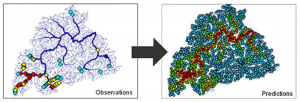Expert panel weighs in on extrapolation limits of stream condition scores

SCCWRP and the California Department of Fish and Wildlife convened an expert panel in September to review how far stream condition scores calculated for a given stream sampling site can be extrapolated upstream and downstream of the site.
The panel’s feedback will be integrated into a detailed statistical analysis of stream condition data from two watersheds to arrive at a final recommendation on extrapolation limits for the California Stream Condition Index. The final report is expected to be completed in December.
The California Stream Condition Index, co-developed by SCCWRP, is a scoring tool for evaluating the ecological health of streams statewide.
Stream managers need to be able to extrapolate California Stream Condition Index scores because they don’t have enough resources to conduct bioassessment work along every kilometer of every stream in California. A stream bioassessment is typically conducted along a site spanning just 150 meters, while there are more than 5,000 kilometers of streams in Southern California alone.
The ability to extrapolate California Stream Condition Index scores will become increasingly important as this scoring tool is integrated into regulatory and stream management programs statewide.
During the panel’s deliberations in September, the panel also recommended exploring an alternate stream condition prediction approach known as spatial statistical network (SSN) modeling. This approach, developed by the U.S. Forest Service, fills in data gaps for stream sites based on distance from existing sampling sites and environmental factors. SCCWRP already has begun evaluating the SSN modeling approach.
More news related to: Bioassessment, Indices of Biotic Integrity